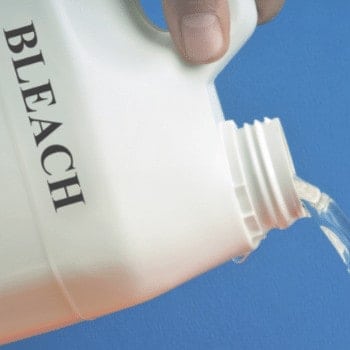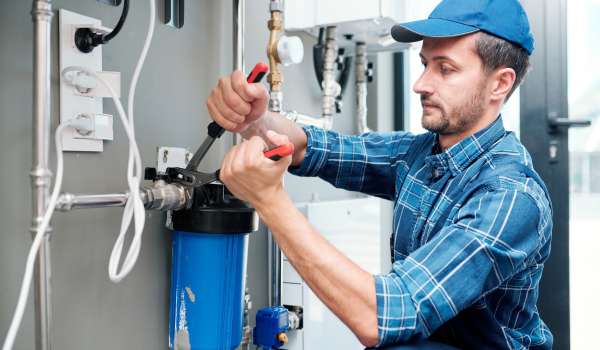If your tap water smells like it came from a swimming pool, you’re not imagining things. That sharp bleachy odor is usually chlorine — a common disinfectant used in public water supplies.
But if it lingers, gets stronger, or shows up in well water, there could be more to the story.
Let’s unpack the most common reasons behind bleachy water smells — and how to clear them up for good.
✅ Quick Takeaways
- 🧪 Chlorine is added to city water to kill bacteria — but too much can leave behind a strong smell.
- 🧻 Shock treatments, pipe corrosion, or malfunctioning chlorinators can all cause chlorine levels to spike.
- 🚿 If your hot water smells bleachy, your water heater could be the culprit.
- 🧾 A simple water test can confirm if the chlorine is too high — or if something else is going on.
- 🚰 Filters like carbon or reverse osmosis systems can remove chlorine and fix the smell fast.
🔍 Why Your Water Smells Like Bleach

Whether your water comes from a city supply or a private well, that sharp, bleach-like smell usually means one thing: chlorine. But the why behind it can vary — and so can the solution.
🌆 City Water Systems
Municipal water treatment plants disinfect water using chlorine or chloramine to kill bacteria and viruses — a process that’s protected public health for decades.
So, why the smell?
- Shock Chlorination: Utilities may temporarily spike chlorine levels to kill microbes during system maintenance or contamination events.
- Longer Travel Distance: The farther your home is from the treatment plant, the more chlorine might be added to maintain safety all the way to your tap.
- Seasonal Adjustments: Higher temperatures or pH fluctuations can weaken chlorine’s effectiveness, leading to temporary over-chlorination.
💡 According to EPA regulations, public water systems must keep chlorine below 4 parts per million — but that doesn’t mean it won’t smell stronger at times.
🏡 Private Wells
Wells aren’t treated by the city — but chlorine may still show up if:
- You Recently Shocked the Well: After adding bleach to disinfect the system, the smell can linger for days. Running water for 15–20 minutes helps flush it.
- A Chlorinator Is Overdosing: Automatic chlorinators can malfunction or be incorrectly set, pumping out too much chlorine.
- The Mix Is Off: A high-concentration bleach solution in your chlorinator can cause over-chlorination and a strong odor.
💡 If your well water keeps smelling like bleach, it may be time to recalibrate or service your chlorination system.
🚰 Is It Safe to Drink Water That Smells Like Bleach?

🤔 Is It Safe to Drink Water That Smells Like Bleach?
Generally, yes — but there’s a reason that smell is making you pause.
Chlorine is added to disinfect your water, it also helps protect against harmful bacteria. According to EPA standards, up to 4 ppm (parts per million) is considered safe for human health.
But here’s where it gets tricky:
- Too little chlorine → your water might harbor bacteria or viruses
- Too much chlorine → may cause skin, eye, or stomach irritation — and it’s harsh on pets, plants, and sensitive aquariums
🧾 Signs It Might Be Overdone:
- The smell is strong and doesn’t fade
- You notice dry skin or a lingering chemical aftertaste
- Your pets won’t drink from the tap (seriously — they’re great testers!)
💡 Even if it’s technically “safe,” high chlorine can still make water unpleasant. If in doubt, test it — or filter it.
🧪 How To Test for Chlorine in Tap Water

If your water smells like bleach, a test is the quickest way to figure out why. The goal? Pinpoint how much chlorine is present — and whether it’s within safe levels.
Here’s a quick rundown of the chlorine types and what they mean:
| 🔍 Type | 💡 What It Means |
|---|---|
| Free Chlorine | Still active and disinfecting your water — should stay under 4 ppm for safety. |
| Combined Chlorine | Has already reacted with contaminants — can cause odor and irritation. |
| Total Chlorine | Free + combined chlorine — helps detect over-chlorination in tap water. |
🧪 How to Test It:
- At-home chlorine test strips (usually sold for pools) give quick results. Just dip and match the color to the chart.
- Liquid reagent test kits offer a more accurate reading — especially for free and total chlorine.
- For deeper analysis (and other contaminants), send a sample to a certified lab like SimpleLab. You’ll get personalized filtration recommendations, too.
💡 Pro Tip: If your chlorine level is consistently high, ask your water provider for recent test reports — they’re required to monitor and publish this data.
🛠️ How To Get Rid of That Bleach Smell

If your tap water smells like a swimming pool, good news: it’s fixable. You’ve got a few solid options depending on how often it happens — and how much effort you want to put in.
💡 Short-Term Fixes
- Boil It: Letting water boil for 15 minutes can remove most chlorine.
- Let It Sit: Pour water into an open container and chill it in the fridge for a few hours. Chlorine will naturally evaporate.
But if the smell sticks around regularly, it’s time for a more permanent solution.
🔧 Long-Term Fixes That Work
| 💧 Solution | 💡 What It Does | ✅ Best For |
|---|---|---|
| 🧱 Carbon Filter | Removes chlorine molecules and improves taste/odor | Pitchers, faucet attachments, or whole-house filters |
| ⚡ Catalytic Carbon | Tackles both chlorine and chloramines — great for city water systems | High-efficiency under-sink units or larger systems |
| ♻️ Distiller | Boils and re-condenses water, removing most impurities | Small batch use — up to 3 gallons per day |
| 🔄 Reverse Osmosis | Removes 99%+ of chlorine, chloramines, VOCs, and more | Point-of-use systems for cooking & drinking water |
💡 Pro Tip: Not all carbon filters remove chloramines — look for systems that use catalytic carbon if your water provider uses them.
✅ Final Thoughts
Chlorine keeps your water safe — but if it smells like pool day every time you turn on the tap, it’s a sign something’s off.
Whether it’s seasonal shock treatments, well chlorination, or just an overzealous city system, too much chlorine isn’t dangerous for most people — but it’s definitely unpleasant.
💡 The good news? It’s fixable.
- A simple water test tells you if chlorine levels are too high.
- A carbon or RO filter clears up the smell — and the taste.
- And if you’re on a well system, keeping your chlorinator dialed in helps avoid the bleachy overload.
Fresh-tasting water shouldn’t require a chemistry degree. With the right setup, you can skip the chlorine smell — and sip with confidence.
 91 people found this helpful. Was this guide helpful to you?
91 people found this helpful. Was this guide helpful to you? 

